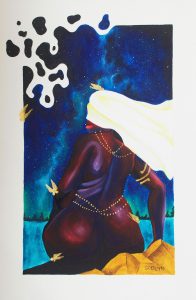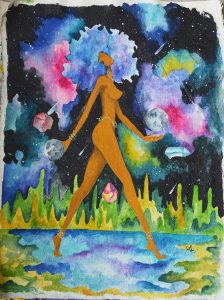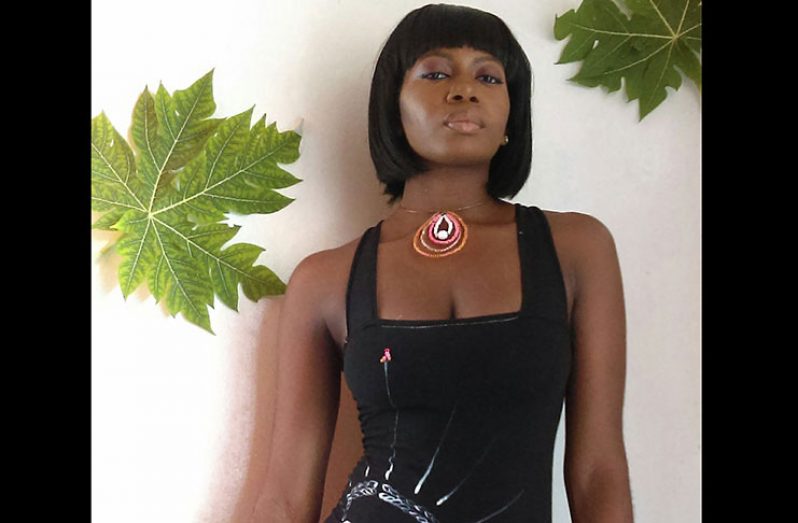It was through a chance encounter last September at a Night Cap event that I was first introduced to the work of Godlyn. I knew in that moment I needed to have a conversation with her about some of the overarching themes prominent in the compelling works she made. Although I took her contact information the same night, it wasn’t until recently that I finally managed to make that long overdue conversation happen. During our sit down we spent about an hour and a half discussing everything from her decision to resettle in Guyana after living in Florida and New York for a few years, to the importance of representation, particularly for Black women and even her thoughts on Amber Rose’s Slut Walk.
“For me art is more than just an expression, it’s a way of being. It’s something I’ve done all my life. I didn’t take it too seriously until I left Guyana and started living in Florida first. I’m not a friend-making person so art was my [solace] and a way of clearing my mind. When I moved to New York five years ago I started seeing that other people made art a career. There was a bit of pressure on me because they had their own style and I wanted to do something different. For those couple of years I would spaz because I didn’t have a signature look for my paintings. So I stopped for a while because I didn’t think I was getting anywhere with it.”
Godlyn went on to describe how she later resumed her creative practice saying, “I started doing more fashion for my high school. After my third fashion show the principal asked me about teaching an art class for the incoming freshman and that’s how I got back into it again. It was a performing arts school and I was the only person invested in the visual arts so he suggested I teach the class for extra credit. After that I tried to find something I could relate to in the paintings. So I thought I would take a different approach instead of just trying to create a different style.”
The approach she is referring to is her decision to make the central theme of her works a more personal narrative that could be equally identifiable as hers as well as that of countless other women around the world.
“Most of the art books that taught you certain techniques only featured Caucasian people. I wanted them to teach me how to paint someone who looked like me. So I started with that. My work is an ode to girls that look like me because I wanted to see someone who looked like me. Representation does matter.
People that have come across my artwork would ask, ‘Is that you?’ When I actually took some time to sit and think about it I realized that subconsciously I was painting myself in the way I wanted to be expressed. I would paint myself in places I wanted to be, for example, in nature, free from stress, worry, criticism and judgment.”
At a time when most persons are actively looking to leave these shores in search of opportunities overseas, Godlyn has chosen instead to return to her place of birth in an effort to escape the noise of the Big Apple.
“Living in New York teaches you that persistence is a great trait for business. I’ve always had a sense of determination because I want to make a difference with my work. If you don’t push to get your work noticed then no one is going to look at you. There’s always a sense of being replaceable because someone else can do what you do. That’s what drives a lot of artists to find their niche. One of the main reasons I left is because of the chaos. I’ve been able to think much clearer now and I can produce work at a level that I’m proud of.”
Another person perhaps even more proud of her accomplishments is none other than Godlyn’s own mother, who was also creatively inclined in years past. It was difficult not to notice the intricately designed and constructed tibisiri fiber art hangings or the floral arrangements and crocheted pieces strategically placed around her home, all of which I wrongfully attributed to Godlyn. In fact, she joined our conversation briefly, speaking with pride about her own start along the self-directed creative path and her daughter’s subsequent decision to venture even further down the same path.
“She did the only thing I didn’t do [art]. I [didn’t follow it up] because I saw that it wasn’t going anywhere.” Speaking on the fiber art pieces she said, “I learned to do those on my own. I didn’t go anywhere to learn how to do them. Years ago I went to a youth club and the lady said she couldn’t teach me because I was left-handed. So I would watch them then come home and try it myself, the same way she [Godlyn] learned to do certain things on her own.”
Elaborately further on the concept of her works Godlyn says, “My art being nude is about freedom, understanding and being proud of your womanhood. It’s not about sex. It’s about being proud of yourself as a woman and being proud of your body, knowing that you deserve respect whether you’re naked or not. That got me some attention from rape victims and persons who were molested. I’ve also had some girls tell me that they’re scared to look at themselves in the mirror when they’re naked because they feel dirty or because they feel it’s unnatural.
I feel like there aren’t enough reminders for women to be proud of their womanhood. There aren’t a lot of things that are exclusive to women that can create a sisterhood for support. I don’t think we have that space here but I would love to be an advocate for something like that.”
Naturally, I was curious to pick her brain about Amber Rose’s Slut Walk, a not-so-new tradition that gained attention through the socialite’s own celebrity pull factor.
“I like the idea. I’m completely cool with women walking naked if they want to and taking back the word “slut” and “whore.” But I also feel like she’s exploiting it. Initially it was a walk for rape victims but now it just looks like a parade. I respect how it’s transitioning but I think it lost the essence of what it was in the beginning. There are still people who don’t look at feminine body parts as feminine body parts. They don’t look at them and respect them as part of a being, a beautiful part of a being. I think there’s a [better] way to get people to  take women more seriously than they’re taking her right now. But I still appreciate that she’s putting [the message] out there.”
take women more seriously than they’re taking her right now. But I still appreciate that she’s putting [the message] out there.”



.jpg)








